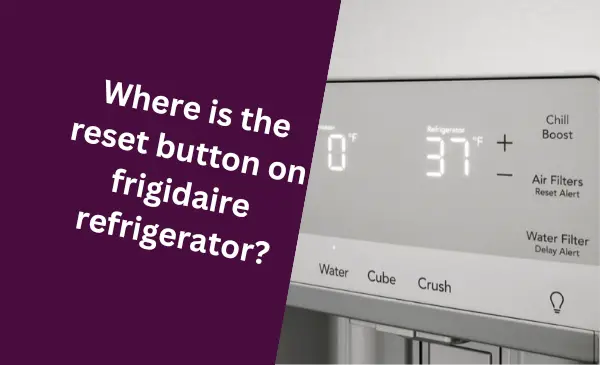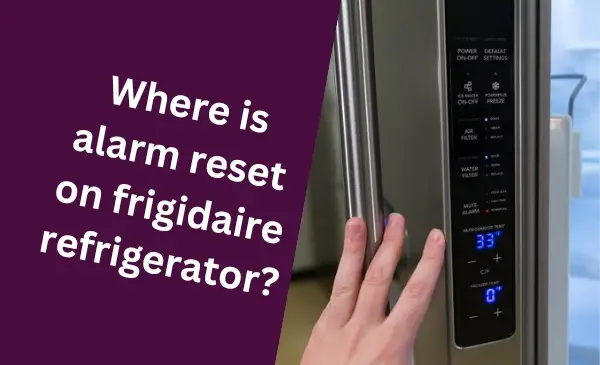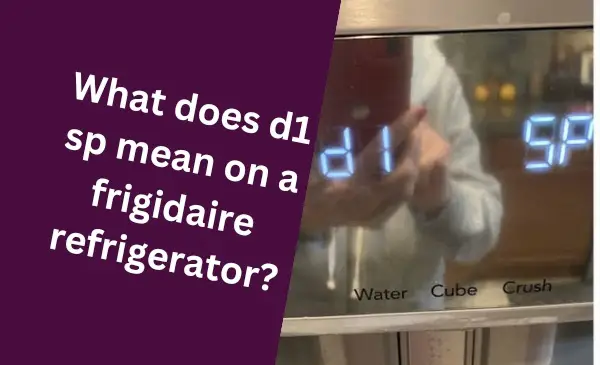The drain tube on a Frigidaire refrigerator is typically located at the back of the unit, near the bottom. It may be necessary to remove the back panel to access and clean the drain tube.
A Frigidaire refrigerator is a reliable appliance that keeps your food fresh and cold. However, over time, you may encounter certain maintenance issues, such as a clogged drain tube. The drain tube plays a vital role in removing excess water from the refrigerator’s defrost cycle.
If it becomes blocked, it can lead to water leakage and potential damage to your unit. That’s why it’s crucial to know the exact location of the drain tube so you can properly maintain it and prevent any disruptions in your fridge’s performance. We will guide you on where to find the drain tube on your Frigidaire refrigerator and how to keep it clean and functional.
Understanding The Importance Of The Drain Tube
A Frigidaire refrigerator is a modern marvel of convenience and efficient food storage. Among its various components, the drain tube plays a crucial role in maintaining the refrigerator’s optimal performance. The drain tube is responsible for removing excess water and condensation that accumulate during the cooling process. Located at the rear of the refrigerator, the drain tube acts as a pathway to channel this water out of the unit.
Understanding the importance of the drain tube is essential to ensure that your Frigidaire refrigerator continues to function smoothly. Without a functioning drain tube, your refrigerator may experience a host of issues that can ultimately impact its performance and even lead to potential damage.
How A Clogged Drain Tube Can Affect The Refrigerator’s Performance
A clogged drain tube can have significant consequences on the overall performance of your Frigidaire refrigerator. When the drain tube becomes blocked or obstructed, it hinders the ability of the refrigerator to eliminate excess moisture. As a result, this excess water can accumulate within the unit and lead to several problems:
- Increased humidity levels inside the refrigerator, which can cause food to spoil faster.
- Formation of ice or frost in the freezer compartment.
- Water leakage onto the floor or within the refrigerator, potentially damaging other components.
- Unpleasant odors are caused by stagnant water and mold growth.
To prevent these issues and ensure optimal performance, it is crucial to keep the drain tube clear and free from any blockages.
Common Signs Of A Clogged Drain Tube
Identifying a clogged drain tube can help you take the necessary steps to rectify the issue promptly. Some common signs of a clogged drain tube in your Frigidaire refrigerator include:
- Water pooling at the bottom of the refrigerator or inside the crisper drawers.
- Visible ice or frost buildup in the freezer compartment.
- Unusual sounds coming from the refrigerator, indicating water is not draining properly.
- Moldy or musty odors emanating from the refrigerator.
If you notice any of these signs, it is recommended to clean or unclog the drain tube to restore the proper functioning of your Frigidaire refrigerator.

Credit: bscappliancerepair.com
Locating The Drain Tube On A Frigidaire Refrigerator
When it comes to maintaining your Frigidaire refrigerator, it’s important to know the location of the drain tube. The drain tube plays a crucial role in preventing water from accumulating inside the fridge and causing potential damage. In this blog post, we will explore the various models of Frigidaire refrigerators and their drain tube placement, offering valuable tips for identifying the drain tube in each model type.
Exploring The Different Models Of Frigidaire Refrigerators And Their Drain Tube Placement
If you own a Frigidaire refrigerator, you may have noticed that the drain tube placement can vary depending on the model. Understanding this can help you locate the drain tube more easily. Let’s take a look at the different types of Frigidaire refrigerators and where you can typically find their drain tubes:
| Frigidaire Refrigerator Model | Drain Tube Placement |
| Side-by-Side Refrigerator | Located at the bottom of the freezer compartment, usually at the rear |
| Top Freezer Refrigerator | Located at the back of the freezer compartment, usually near the bottom |
| Bottom Freezer Refrigerator | Located at the back of the freezer compartment, near the bottom |
Tips For Identifying The Drain Tube In A Side-by-side Refrigerator
If you own a side-by-side Frigidaire refrigerator, locating the drain tube may seem a bit challenging. Here are a few tips that can help you identify the drain tube:
- Start by removing all items from the freezer compartment.
- Look for a small opening or hole at the bottom of the freezer compartment’s rear wall.
- The drain tube may be attached to a drip pan or connected to a drain hole beneath it.
By following these tips, you should be able to locate the drain tube in your side-by-side refrigerator easily.
Finding The Drain Tube In A Top Freezer Refrigerator
Top freezer Frigidaire refrigerators typically have their drain tubes located at the back of the freezer compartment. To find the drain tube in your top freezer refrigerator, here’s what you can do:
- Clear out any items from the freezer compartment.
- Check the rear wall of the freezer compartment, near the bottom.
- Look for a small opening or hole where the drain tube should be connected.
Following these steps will help you pinpoint the drain tube in your top freezer refrigerator.
Locating The Drain Tube In A Bottom Freezer Refrigerator
For those with a bottom freezer Frigidaire refrigerator, the drain tube can be found at the back of the freezer compartment. To locate the drain tube in your bottom freezer refrigerator, here’s what you need to do:
- Clear out any items from the freezer compartment.
- Look for a small opening or hole at the rear of the freezer compartment, near the bottom.
- You may also notice a drip pan or a drain hole beneath it, where the drain tube is connected.
By following these steps, you can easily locate the drain tube in your bottom freezer refrigerator.
Steps To Access And Clean The Drain Tube
If you own a Frigidaire refrigerator, you may have noticed water collecting at the bottom of the fridge or even leaking onto your kitchen floor. This could be a sign that your drain tube is clogged with debris and needs to be cleaned. In this blog post, we will guide you through the steps to access and clean the drain tube, ensuring proper functioning and preventing any future water damage.
Tools Required For Accessing And Cleaning The Drain Tube
Before you begin, gather the following tools:
- A screwdriver (check your appliance’s manual to determine the type of screwdriver required)
- A soft cloth or sponge
- A small bucket or container
- A solution of warm water and mild detergent
Precautions To Take Before Working On The Drain Tube
It is important to take necessary precautions to ensure your safety before working on the drain tube. Follow these guidelines:
- Unplug your refrigerator from the power outlet to avoid any electrical shock.
- Protect your flooring by placing a towel or some newspapers near the refrigerator.
- Wear gloves to protect your hands from any sharp edges or cleaning chemicals.
Step-by-step Instructions For Accessing The Drain Tube
Now that you have the tools ready and have taken the necessary precautions, follow these steps to access the drain tube:
- Locate the drain tube at the back of your Frigidaire refrigerator. It is usually located near the bottom, behind a plastic cover.
- Use a screwdriver to remove the screws securing the cover.
- Once the cover is removed, you should see the drain tube.
- Inspect the tube for any visible signs of blockage or debris. If you notice any, proceed to the next section on cleaning the drain tube.
How To Clean And Remove Debris From The Drain Tube
Now that you have accessed the drain tube and identified any blockage or debris, follow these steps to clean it:
- Using a soft cloth or sponge, gently wipe away any visible debris from the surface of the drain tube.
- Prepare a solution of warm water and mild detergent.
- Take a cloth or sponge and dip it into the solution.
- Carefully insert the cloth or sponge into the drain tube and gently clean the interior, removing any dirt or debris.
- Rinse the drain tube with clean water to remove any remaining soap residue.
- Once the drain tube is clean and free of debris, reassemble the plastic cover and secure it with the screws.
- Plug your refrigerator back into the power outlet.
By following these steps, you can effectively access and clean the drain tube of your Frigidaire refrigerator. This simple maintenance task will help prevent water buildup and potential damage to your appliance. Remember to perform regular checks and cleaning of the drain tube to ensure the optimal performance of your refrigerator.
Preventing Drain Tube Clogs In The Future
Regular maintenance of the drain tube in your Frigidaire refrigerator is essential to ensure proper drainage and prevent clogs. By following a few simple steps and incorporating a recommended cleaning schedule, you can keep your drain tube clear and avoid any future issues.
Regular Maintenance Tips To Keep The Drain Tube Clear
Here are some regular maintenance tips that can help you keep the drain tube clear:
- Regularly inspect the drain tube and check for any signs of blockages or buildup.
- Remove any debris or food particles that may have accumulated near the entrance of the drain tube. A gentle wipe with a damp cloth can suffice.
- Ensure that the refrigerator is level, as an uneven placement can cause improper drainage and potential clogs in the drain tube.
- Periodically flush the drain tube with warm water to remove any potential obstructions.
Recommended Cleaning Schedule For The Drain Tube
To maintain a clear and functioning drain tube, it is advisable to follow this cleaning schedule:
| Frequency | Action |
| Every 3 months | Remove the drain tube from its connection and flush it with a mixture of baking soda and vinegar. Let the solution sit for about 15 minutes before rinsing with warm water. |
| Every 6 months | Inspect the drain pan located at the back of the refrigerator. Clean it and ensure it is free from any debris or mold growth. |
Using Baking Soda And Vinegar To Prevent Clogs
Baking soda and vinegar can be effective in preventing clogs in the drain tube. Here’s a step-by-step guide:
- Mix 1/4 cup of baking soda with 1/4 cup of vinegar.
- Pour the mixture into the drain tube and allow it to sit for about 15 minutes.
- Rinse the drain tube with warm water to flush out any residue.
Other Preventive Measures To Avoid Drain Tube Issues
Aside from regular maintenance and using baking soda and vinegar, here are some additional preventive measures you can take to avoid drain tube issues:
- Ensure that only small food particles go down the sink and not larger pieces that could cause clogs.
- Regularly clean the refrigerator and ensure that liquids and expired food are properly disposed of.
- Avoid placing hot or boiling items directly on the refrigerator shelves, as these can cause condensation and potentially lead to drain tube issues.
- If you notice any signs of a clogged drain tube, such as water pooling in the bottom of your refrigerator, take immediate action to prevent further damage. You can use a pipe cleaner or a small brush to gently remove any clogs.
Common Issues And Troubleshooting Tips
Dealing with water leaks in your Frigidaire refrigerator can be frustrating. One common culprit behind these leaks is a clogged or faulty drain tube. The drain tube is responsible for carrying away the excess moisture and condensation that accumulates inside the refrigerator. Over time, this drain tube can become blocked with ice, food particles, or other debris, leading to water leaks.
However, before assuming the drain tube is the cause, it’s essential to consider other possible reasons for water leaks in your Frigidaire refrigerator.
Identifying Other Possible Causes Of Water Leaks In A Frigidaire Refrigerator
A water leak in your refrigerator can have various origins. While a clogged or malfunctioning drain tube is a common issue, it’s crucial to eliminate other potential causes before addressing the drain tube. Here are some other potential sources of water leaks in your Frigidaire refrigerator:
- Blocked or frozen water supply line: Check if the water supply line feeding your refrigerator’s ice maker and water dispenser is blocked or frozen. A kinked or damaged supply line can also cause leaks.
- Cracked water filter housing: Inspect the water filter housing for cracks or damage. A damaged housing can result in water leaks.
- Defective water inlet valve: The water inlet valve controls the flow of water into the refrigerator. If it is faulty or damaged, it can cause leaks.
- Improper temperature regulation: In some cases, improper temperature settings can cause excessive condensation, leading to water leaks. Ensure your refrigerator is set to the correct temperature.
- Worn-out door gaskets: Check the condition of the door gaskets. If they are worn out or not sealing properly, moisture can escape and cause leaks.
Troubleshooting Tips For Resolving Drain Tube-related Problems
If you have eliminated other potential causes and suspect the drain tube is the culprit behind the water leaks, here are some troubleshooting tips to resolve drain tube-related issues:
- Defrost the refrigerator: Start by defrosting your refrigerator. Turn off the unit, remove all food, and let the ice inside melt completely. This action can help clear any ice blockages in the drain tube.
- Clean the drain tube: Once the refrigerator is defrosted, locate the drain tube at the back of the fridge. Using a thin, flexible brush or pipe cleaner, gently remove any debris blocking the tube. Do not use sharp objects that could damage the tube.
- Flush the drain tube: After cleaning, flush the drain tube with a mixture of warm water and mild detergent. This step helps remove any remaining residue. Rinse thoroughly to ensure the tube is clear.
- Check the drain pan: While troubleshooting the drain tube, inspect the drain pan located beneath the refrigerator. Ensure the pan is clean and properly positioned.
- Regular maintenance: To prevent future drain tube issues, it’s essential to perform regular maintenance on your Frigidaire refrigerator. Keep the drain tube clean and free from debris, and check for any signs of leakage or blockages.
When To Seek Professional Help For Drain Tube Issues
While some drain tube-related problems can be resolved through troubleshooting, there are instances where professional assistance is necessary. If you are unsure or uncomfortable with performing the troubleshooting steps mentioned above, it’s best to contact a qualified refrigerator technician.
Seeking professional help ensures that the drain tube and other components of your Frigidaire refrigerator are properly inspected, repaired, or replaced if needed. Remember, it’s essential to address water leaks promptly to prevent further damage and maintain the optimal performance of your refrigerator.
Conclusion
The drain tube on a Frigidaire refrigerator plays a crucial role in preventing water accumulation and potential damage. By locating and properly maintaining this component, you can ensure the smooth functioning of your appliance. Remember to regularly clean and clear the drain tube to avoid clogs and leaks.
Keeping your refrigerator in peak condition will help prolong its lifespan and save you from costly repairs.
Hello Readers, I am Mechanic Shuvo, a seasoned refrigerator solution expert with over 11 years of hands-on experience in the field. Throughout my career, I've dedicated myself to understanding the ins and outs of refrigeration systems, honing my skills as a refrigerator mechanic. My passion for these appliances led me to create the website "refrigeratorsolutionsguide.com," where I aim to share my wealth of knowledge and expertise with others.
Over the years, I've encountered a wide range of refrigerator issues and have successfully resolved them all. From common problems like temperature fluctuations and strange noises to more complex technical issues, I've seen it all. Through my website, I hope to provide practical solutions, insightful tips, and guidance to help you keep your refrigerators running smoothly.






